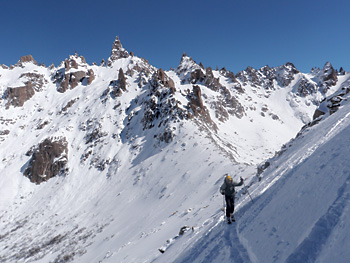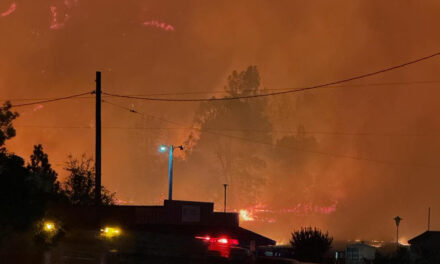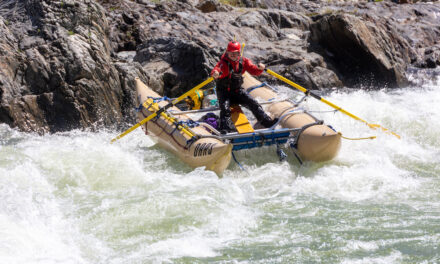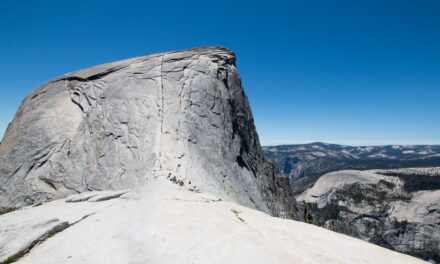- Tahoe’s Nevada Beach Tops the List of Hard-to-Book Campgrounds - 07/17/2024
- Cannabis Watershed Protection Program Cleans Up Illegal Grow Sites - 07/10/2024
- French Fire - 07/05/2024
Life isn’t all wine and August fluff for Nor Cal newlyweds in Argentina’s high peaks, but it’s close enough
By Wendy Lautner • Photos by Wendy Lautner and Greg Speicher

Traversing a vertical world.
After tying the knot in California’s summer heat, my new hubbie, Greg, and I were feeling the need to cool off. So we high-tailed it to the Southern Hemisphere for the novelty of a couple Sierra ski rats sharing powder turns in August.
Our happily-ever-after started with about 18 hours on various airplanes and in various airports before landing in Buenos Aires. We spent our first few days there sleeping off the jet lag between multiple bottles of Malbec and mouthwatering steak dinners, tango shows and futbol games.
Buenos Aires, home to 3 million people, is clean, organized and renowned for its cosmopolitan character. It’s nice, but we had come to ski and that meant leaving Buenos Aires’s cafes and European flair behind.
One Long, Blissful Bus Ride
Twenty hours of Pampas (flat-as-a-pancake cattle grazing grounds) separate bustling Buenos Aires from the snow-covered Andes in central Patagonia outside of Bariloche, our destination. That might seem like a long way (like driving to Denver after flying into San Francisco). But, in Argentina there is one marvelous invention that makes such 20-hour drives much more palatable – the Exclusivo!
The Exclusivo is a first-class bus equipped with La-Z-Boy-like seats that fold down flat into beds. We bought two tickets on Via Bariloche ($70US per person) and settled in for the 20-hour ride. There was plenty to keep us entertained. A bus steward served breakfast, lunch, dinner, appetizers, dessert, and even a midnight snack. There were movies (and most of them didn’t even skip) and we could bring our own booze! After two bottles of wine and two liters of Quilmes (the national equivalent of Budweiser, though far superior), I discovered my new husband actually enjoys watching romantic comedies!
My chick-flick man and I didn’t think our 20-hour-bus-ride could get any better when, at like five past midnight, we heard the bus steward ask, “Whiskey, champagne, cookies?”
Yes, yes, and yes!
Cerro Catedral and Cervezerias
We arrived in Bariloche the next day and found fluffy, fat flakes falling steadily on the holly tree beside the lakeside cottage we’d rented for the next four days. I must have been overcome by the infamous newly wed bliss because all I could think about was getting started on the official honeymoon sport … skiing!
Bariloche is set on the principal lake of the region, Lago Nahuel Huapi, a large, long lake with fjord-like fingers snaking through the mountainous landscape. Outside of Bariloche is Cerro Catedral, the Squaw Valley of Argentina. More than a dozen chairlifts, pommel lifts, tow ropes and gondolas access 1,200 skiable hectares. The resort tops out at 7,150 feet, which, if you’re lucky, is above snow line.
And we were lucky, the first day. We showed up on Aug. 23, the first true powder day at the end of a meager season, and shoved our way into the gondola with the two other gringo teleskiers at the mountain that day. But after only an hour or so, our mission to shred every clean line we could see became downright urgent. We thought Argentinians didn’t ski off-piste? Wrong!
We still had fun, until the storm blocked out the sun and turned to rain! Then it was time to start on the Cervezeria (brewery) tour, which was great for apres ski (wet on the outside, wet on the inside!).
But the rain wore on for days. So we ate a lot of food, drank a lot of wine, and engaged in the other official honeymoon sport.
Into the Backcountry
Finally, the wet storm that washed away much of the snowpack at Cerro Catedral’s base at 6,000 feet, ended with a cold snap that dropped six to 12 inches of fluff on top of an icy crust. Plus, the forecast called for clear skies and temperatures peaking around 40 degrees for the next four days, with a storm arriving at the end of the fourth day.
We made haste to a backcountry hut known as Refugio Frey, about a four-to-six-hour ski from the top of Cerro Catedral. There are plenty of routes to Frey, but we opted for one that featured south-facing chutes (remember, this is the southern hemisphere) in a bowl behind the summit of Punta Princesa (6,725 feet).
From the top of one of Cerro Catedral’s newer lifts, the idea is to contour the jagged ridgeline on the north side of Princesa, heading west over the wind-hammered terrain. Three prominent pinnacles guard the entrances into the sweet bowls behind Princesa. We found a good place to crest and were rewarded with untracked feather-dust. Time to let ’em rip!
After the main pitch, it was a fast glide to the woods bordering a streambed. We crossed the stream and skinned up through the trees to a low point where another small stream drains the south side of this valley. At the top of the saddle, Refugio Frey (5,576 feet) sits humbly at the outlet of the snow-covered Lago Tonchek.
We arrived around four in the afternoon with the day’s last warm rays on our skin. Hardy-looking folks greeted us with warm smiles as we settled into our new base for the next few days.
Rustic Hut, Full Keg
Inside the charmingly rustic hut there was a boot room, a staffed kitchen, and a commodious dining room with a woodstove and drying rack at its center. Upstairs, there were 28 bunk spots with foam mats.
After choosing our sleeping area and dropping our packs, we made a stop by the tap downstairs to fill up on frothy, dark beer and watch the evening shadows climb up the golden Frey, a granite pinnacle scaled frequently by strong climbers. Our hut host, Paula, was making the ascent when we arrived, in between skiing steep lines, cooking dinner and kneading the dough for the next morning’s breakfast toast.
When the landscape turned gray and a nearly full moon illuminated the eastern valley, the evening revelry began. Paula and Hernan, our other hut host, prepared appetizers, dinner, and dessert. Wine bottles were pulled off the mantles and uncorked. Dark beer ran in a steady stream from tap to pint glass. The hut was packed with more than a dozen folks, mostly Argentinian. We were the sole Americans; a guy named Jan, the only European. Boisterous conversations in Spanish and English and the golden glow of candlelight added to the warmth of this place as we filled our bellies and bloodstreams with fuel and fire for backcountry exploring.
South-Facing Stashes
The skiing around Frey is superb and easy to access. Narrow, east-facing chutes form a steep amphitheatre right out the back door. The Argentinians liked to ski these icy lines, making jagged zipper-line skin tracks all the way up. Greg and I preferred to hunt powder on the south-facing slopes, of which there were plenty. We found a route to the ridgeline above Lago Schmol, a step above Lago Tonchek, with cold, south-facing powder stashes all the way back to the hut. When conditions are right, the lines that can be skied are virtually inexhaustible.
But then, the weather might turn on you, as it did on us the day we had to hike out. In the three nights we spent at the Refugio, many groups came and left this backcountry nirvana. As luck would have it, the day of our planned departure a newly arrived Argentinian couple also planned to hike out, despite the impending storm. We decided to tag along.
That plan went awry practically from the get-go when our “leader” started kick-turning up the steepest part of a slope on which we had scoped a much gentler, quicker, more reasonable ascent option. We bailed on the icy, steep kick-turns which Hernan assured me were “not easier, but more fun” than the line I pointed out to the top. Even after our detour we managed to meet their group below the final pitch above Lago Schmol.
On All Fours
That’s when my legs started shaking like a snagged spider web, 20 feet up a frighteningly steep slope covered in feathery powder — the kind that squeaks and squirts out under your skis — over a layer of ice.
I took off my skis and fastened them to my backpack to bootpack the slope. No more than five steps into my ascent I slipped and slid well below my starting point, a sluff of powdery snow falling with me.
Panic percolated my bloodstream. “Can somebody please call a helicopter rescue?” I thought about crying after the sluff had stopped and I froze in fear with snow piled up on my sleeves and the wind howling outside my hood.
Shaking off my momentary paralysis, I began to ascend on all fours, punching my fists into the snow and trying to grip the ice layer beneath the fluff with my fingernails through my mittens. Tenuous, yes.
Making the top, where five others waited, was at once comforting and agonizing. The storm engulfed us. Visibility was about ten feet. Heading off into the white abyss was incredibly disorienting.
For the next four hours it was one icy, unstable footstep in front of the other. The cozy world inside of my hardshell echoed with uncertainty but also a dogged determination not to die in the Andes on my honeymoon.
At one point, we hiked up to what seemed like the top of the ridgeline, an attempt at orientation. Greg asked Jeremiah, our leader, “So do you think you know where we are now?” He gave a “mas o menos” gesture that made me do a quick assessment of the survival supplies we carried in our packs — some food, sleeping bags, headlamps, and, did Greg pack that emergency shelter?
I stared deeply into Greg’s eyes and said in the most upbeat tone I could muster, “I think we could probably stand a night out here if we had to.” No response was necessary as we kept on in what seemed to be more and more like the right direction. And finally, it was.
Matrimonial Metaphors
The blur of travel during a complete whiteout exhausted all of us, and the rain we endured as we continued down the mountain to civilization stole every last ounce of energy that remained. But still, I couldn’t help snickering to myself between whimpers as we bumped our way through thick clouds and over uneven terrain on the way to the resort.
This is what we do for fun. We bundle ourselves up and head out into the elements, enjoying its carefree pleasures and enduring its heaping shares of whoop-ass. And what better metaphorical experience — joy and laughter, discomfort and fear, struggles and uncertainty — could a newlywed couple embarking on a lifetime together have in one trip?
Then again, perhaps we should have chosen to honeymoon at a tropical beach. But where’s the adventure there?
Wendy and Greg are still married as of this writing and after a second honeymoon paddling whitewater rivers in the Himalaya, the Truckee couple finally made it to a tropical beach in Cozumel, Mexico, where they learned to scuba dive. No doubt a few marriage metaphors could be drawn from that trip, too. … Wendy is the author of “Day & Section Hikes Pacific Crest Trail: Northern California,” a guidebook scheduled for release by Wilderness Press in May.













